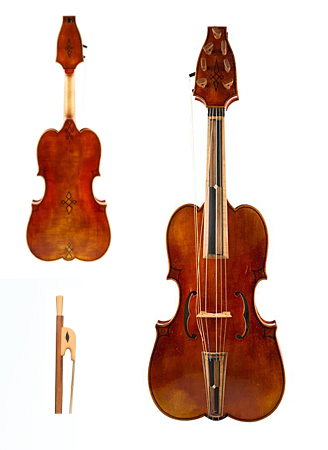
Owner: HWMC
Catalog#: 2CL-CHLT-175
Violin Family
'Lira da braccio' Henning Aschauer
Oberammergau, Bavaria Germany
Henning Aschauer
Woods, ebony
1985 C.E.
Lira Body Length: 28.7 in
Bow Length: 27.3 in
Strings – Lutes – Violin Family
Inside marked: ‘Henning Aschauer Oberammergau 1985’
Bow marked: ‘Aschauer’
The lira da braccio was especially popular in Italy during the Renaissance among court and city musicians. It evolved from earlier instruments such as the medieval fiddle, or vielle. Like the vielle, it had a leaf-shaped pegbox with frontal pegs, but unlike its predecessor it was played on the arm which is reflected in its name (‘braccio’ means ‘arm’ in Italian).
The lira da braccio most commonly had 7 strings, 5 of which were tuned like the vielle (d–g–d’–a’–e’’), with two additional drone strings that were tuned in octaves outside the fingerboard to serve as drone strings. These drone strings offered a base for the melody and provided harmonic support. The lira da braccio was played with a long bow that had a large curve, which allowed for larger chords and was ideal for producing harmonic and polyphonic textures to accompany singing or dancing.
The lira played an important role in both chamber music and was associated with prestigious cultural events. Artist Leonardo da Vinci was known for his interest and support of the lira as not only a musical instrument but also from an artistic perspective. Although the lira da braccio is no longer in common use, it continues to remain as an important part of cultural heritage of Renaissance music.
Resource: http://www.baroque-instruments.com/musical-instruments/lira-da-braccio/
